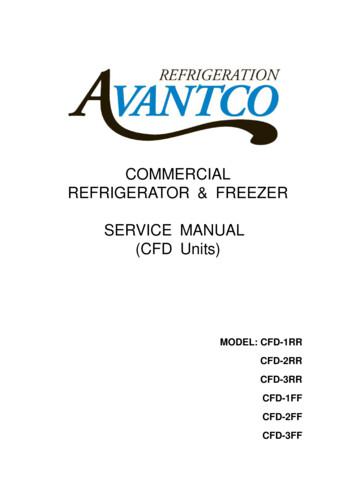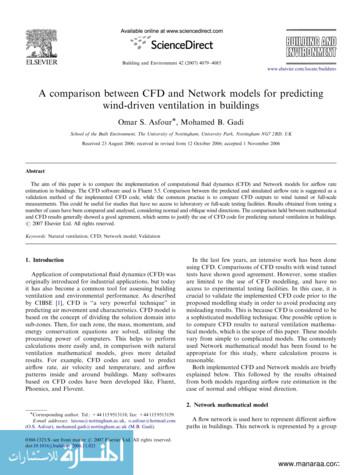Current Practice Unstructured Grid CFD Results For 3rd AIAA High . - NASA
Engineering, Test & TechnologyBoeing Research & TechnologyCurrent Practice UnstructuredGrid CFD Results for 3rd AIAAHigh Lift Prediction WorkshopAndrew Cary, Mohamed Yousef, Mori Mani, and Pei LiBoeing Research and TechnologyJanuary 12, 2018Copyright 2017 Boeing. All rights reserved.
Boeing Research & Technology Aeromechanics TechnologyOverview Completed series of simulations based on High Lift PredictionWorkshop 3 cases to assess flow solvers, committee-providedgrids, and turbulence models Specific focus on JAXA Standard Model without pylon (Case 2a) Emphasis is on comparing CFD results, not comparison to experiment CFD Solvers: BCFD, CFD , GGNS Grids: JAXA (D), ANSA (E), VGRID (C) Turbulence Models: Spalart-Allmaras (SA), SA-QCR, SA-RC-QCR Principal results: Different CFD codes on same/similar meshes with same turbulencemodel generate similar results Mesh and turbulence model differences lead to different results Once significant flow separation occurs, families of pseudo-solutionattractors appear that are associated with flow separation from differentslat bracketsCopyright 2017 Boeing. All rights reserved.
Boeing Research & Technology Aeromechanics TechnologyJSM Case overview (case 2a)Slat bracketsMach 0.172Rec 1.93Mc 529.2 mmCopyright 2017 Boeing. All rights reserved.
Boeing Research & Technology Aeromechanics TechnologyMesh Comparison - SurfaceComparable faces, despitedifferent resolutionTighter cornerresolutionJAXA Grid (D)Grid SeriesGrid TypeC1 - VGRIDD – JAXAE – ANSAE2 - ANSA (fine)TetrahedraMixed ElementMixed ElementMixed ElementCopyright 2017 Boeing. All rights reserved.ANSA Grid (E)Number ofVolume Cells96.6M120M107M165MNumber ofVolume .81MNumber ofHex/Prism cellsN/A81.3M79.5M129M
Boeing Research & Technology Aeromechanics TechnologyMesh Comparison - VolumeFiner off-bodyresolutionJAXA Grid (D)Grid SeriesGrid TypeC1 - VGRIDD – JAXAE – ANSAE2 - ANSA (fine)TetrahedraMixed ElementMixed ElementMixed ElementCopyright 2017 Boeing. All rights reserved.ANSA Grid (E)Number ofVolume Cells96.6M120M107M165MNumber ofVolume .81MNumber ofHex/Prism cellsN/A81.3M79.5M129M
Boeing Research & Technology Aeromechanics TechnologyVolume Mesh StatisticsCumulative cellsPrism Cells Bins of wall distance (geometric growth)Cells colored by aspect ratio (green division is AR 2)35% cells are within y approx. 5080% cells are within 5% MAC of bodyCopyright 2017 Boeing. All rights reserved.
Boeing Research & Technology Aeromechanics TechnologyMesh Comparison – Volume MetricsJAXA Grid (D)ANSA Grid (E) ANSA grid packs more cells in lower part of boundary layer ANSA grid has less overall resolution between 5% and 25% chord,but more resolution at about 1 chord Image does not reflect spacing/distribution on surfaceCopyright 2017 Boeing. All rights reserved.
Boeing Research & Technology Aeromechanics TechnologyLift Coefficient: Result Consistency Results with same grid andturbulence model generallyconsistent JAXA (SA-RC-QCR) resultsshow strong consistency acrossflow solvers, users ANSA results show largerE2spread for both SA-QCR andSA-RC-QCR; primarilyassociated with slat bracketseparation Solutions cluster based onlocation of slat bracketseparations (annotation)Copyright 2017 Boeing. All rights reserved.Mesh: JAXA, ANSA, VGRID, EPICSolver: BCFD, CFD , GGNSTurbulence Model:SA,SA-QCR,SA-RC-QCR
Boeing Research & Technology Aeromechanics TechnologyLift Coefficient: SA-RC-QCR Recommended variation ofSA turbulence model Results sensitive to meshbut reflect different pseudosolution attractorsE2Copyright 2017 Boeing. All rights reserved.Mesh: JAXA, ANSA, VGRID, EPICSolver: BCFD, CFD , GGNSTurbulence Model:SA,SA-QCR,SA-RC-QCR
Boeing Research & Technology Aeromechanics TechnologyLift Coefficient: Grid Sensitivity ANSA mesh appears more sensitive to turbulence model thanJAXA mesh Solution variation with iteration less than symbol size; typically 3-5orders of magnitude residual convergenceCopyright 2017 Boeing. All rights reserved.
Boeing Research & Technology Aeromechanics TechnologyLift Coefficient – Overall Comparison General agreement untilsignificant flow separation Consistent trends for given mesh(multiple flow solvers andturbulence models) JAXA grid particularly tightlyclustered Adapted mesh results similar untilfinal angle of attack Large spread near key areas(CLmax, AoAmax) limitsengineering usefulness in theseregionsRelative difference from experimental data to facilitate comparisonCopyright 2017 Boeing. All rights reserved.Mesh: JAXA, ANSA, VGRID, EPICSolver: BCFD, CFD , GGNSTurbulence Model:SA,SA-QCR,SA-RC-QCR
Boeing Research & Technology Aeromechanics TechnologyPseudo-Solution Robustness (soln interp)ANSA, CL 2.61JAXA, CL 2.76ANSA, CL 2.52Restarted from JAXA BCFD SA-QCR, 18.58 Interpolate JAXA solution onto ANSA grid and reconvergeCopyright 2017 Boeing. All rights reserved.
Boeing Research & Technology Aeromechanics TechnologyPseudo-Solution Robustness (change CFL)BCFD, JAXA grid, SA-QCR Changing CFL number switches pseudo-solution sometimes(indication of strength of attractor) Need flow solver convergence to assess grid, turbulence model,but what if multiple solutions?Copyright 2017 Boeing. All rights reserved.
Boeing Research & Technology Aeromechanics TechnologyTime-Accurate Simulation ImpactInstantaneousSolutionTime-AveragedSolution Start time-accurate DDES solutionon JAXA grid, SA-QCR, 20.59 Time-averaged solution shows noseparation Lift comparable to RANSRANS SolutionCopyright 2017 Boeing. All rights reserved.
Boeing Research & Technology Aeromechanics TechnologyTime-Accurate Simulation Pressure DistributionInboardOutboard Inboard pressure cut (A-A) compare well to RANS; show littlevariation Outboard pressure cut (H-H) shows average flow is attached;improved comparison to experimental measurementCopyright 2017 Boeing. All rights reserved.
Boeing Research & Technology Aeromechanics TechnologySummary Effort focused on current technology flow solvers with committeeprovided meshes and standard turbulence models Generally good agreement among solvers for same grid andturbulence model Grid convergence has not been assessed Significant amount of grid very close to aircraft JAXA committee-provided grid shows less variation in results thanANSA grid, but had less off-body resolution Solver identifies multiple pseudo-solutions that can sometimes beperturbed to different attractors Interpolation of new solutions Change CFL number Running time accurate may lead to improved comparison toexperimentCopyright 2017 Boeing. All rights reserved.
Copyright 2014 Boeing. All rights reserved.
Boeing Research & Technology Aeromechanics TechnologyC-VGRID meshCopyright 2017 Boeing. All rights reserved.
Boeing Research & Technology Aeromechanics TechnologyEPIC meshCopyright 2017 Boeing. All rights reserved.
Emphasis is on comparing CFD results, not comparison to experiment CFD Solvers: BCFD, CFD , GGNS Grids: JAXA (D), ANSA (E), VGRID (C) Turbulence Models: Spalart-Allmaras (SA), SA-QCR, SA-RC-QCR Principal results: Different CFD codes on same/similar meshes with same turbulence model generate similar results
refrigerator & freezer . service manual (cfd units) model: cfd-1rr . cfd-2rr . cfd-3rr . cfd-1ff . cfd-2ff . cfd-3ff . 1 table of contents
simulations were compared with structured-grid CFD data at Mach numbers from 0.3 to 1.2 at nozzle pressure ratios up to 7.2. Simulations of an isolated nacelle with a supersonic cruise nozzle were compared with wind tunnel experimental data and structured-grid CFD data at Mach numbers of 0.9 and 1.2, with a nozzle pressure ratio of 5.
430 allocation to elianto cfd o&m 20,577.32 440 allocation to trillium west cfd o&m 27,267.00 450 allocation to west park cfd o&m 70,008.22 460 allocation to festival ranch cfd o&m 177,790.54 480 allocation to tartesso west cfd o&m 27,809.17 481 allocation to anthem sun valley cfd o&
The fine nozzle grid (listed in Table 2) had cells half the size of the baseline grid inside the nozzle. In addition, the fine nacelle grid also had less stretching along the nacelle. The fine nacelle surface grid was also used to generate a grid with a y 50 for simulations with a wall. Simulations were computed at the design NPR of 5
CFD Analysis Process 1. Formulate the Flow Problem 2. Model the Geometry 3. Model the Flow (Computational) Domain 4. Generate the Grid 5. Specify the Boundary Conditions 6. Specify the Initial Conditions 7. Set up the CFD Simulation 8. Conduct the CFD Simulation 9. Examine and Process the CFD Results 10. F
The CFD software used i s Fluent 5.5. Comparison between the predicted and simulated airflow rate is suggested as a validation method of the implemented CFD code, while the common practice is to compare CFD outputs to wind tunnel or full-scale . Both implemented CFD and Network models are briefly explained below. This followed by the .
–Turbulence modeling Wilcox k-w Kok k-w BSL, SST k-w Explicit Algebraic Reynolds Stress Model (EARSM) extensions –Transition prescription . Grid Alpha CFD Cl CFD WB Fine Cl exp 0.49º 0.4984 Alpha exp. Medium 0º 0.4935 Coarse 0º 0.4947 Grid Alpha CFD Cl CFD WBPN.
Artificial Intelligence of December 2018 [5] and in the EU communication on Artificial Intelligence for Europe [6], including billions of Euros allocated in the Digital Europe Programme _ [7]. This is due to potential economic gains (e.g. see OECD reports on AI investments [8] and on AI patents [9]), as well as economic risks (such as the issue of liability – Liability for Artificial .























